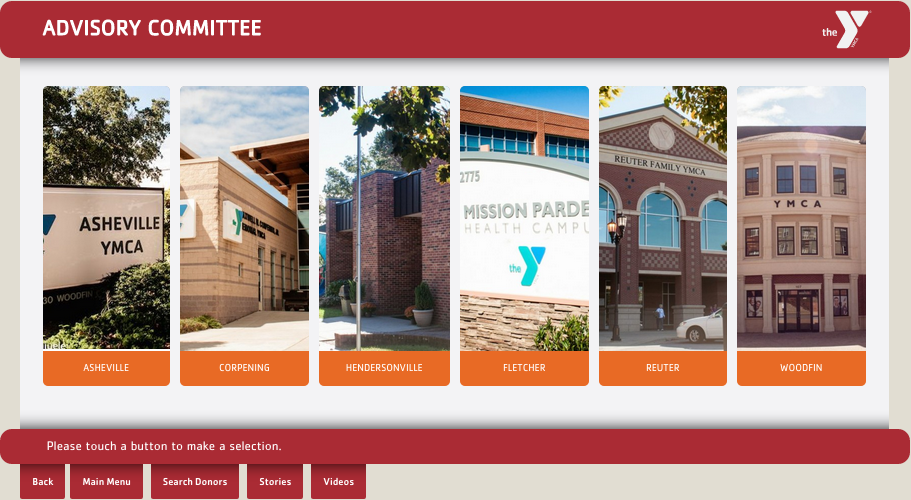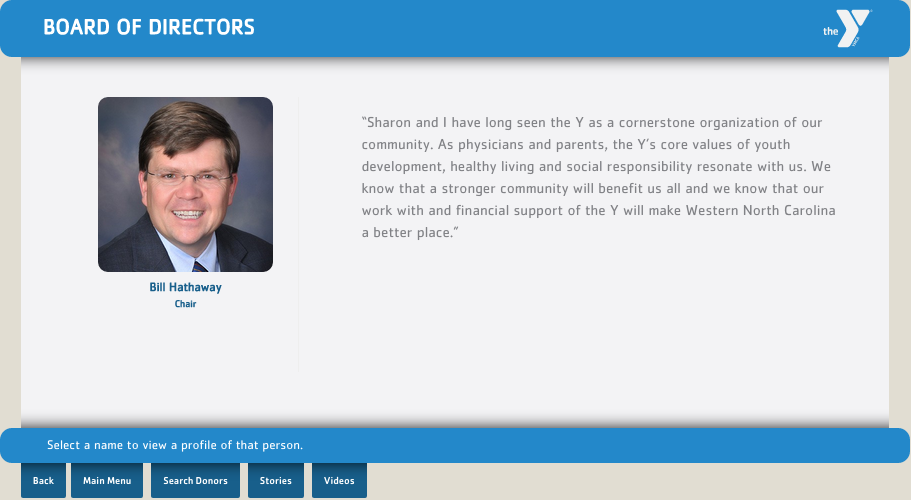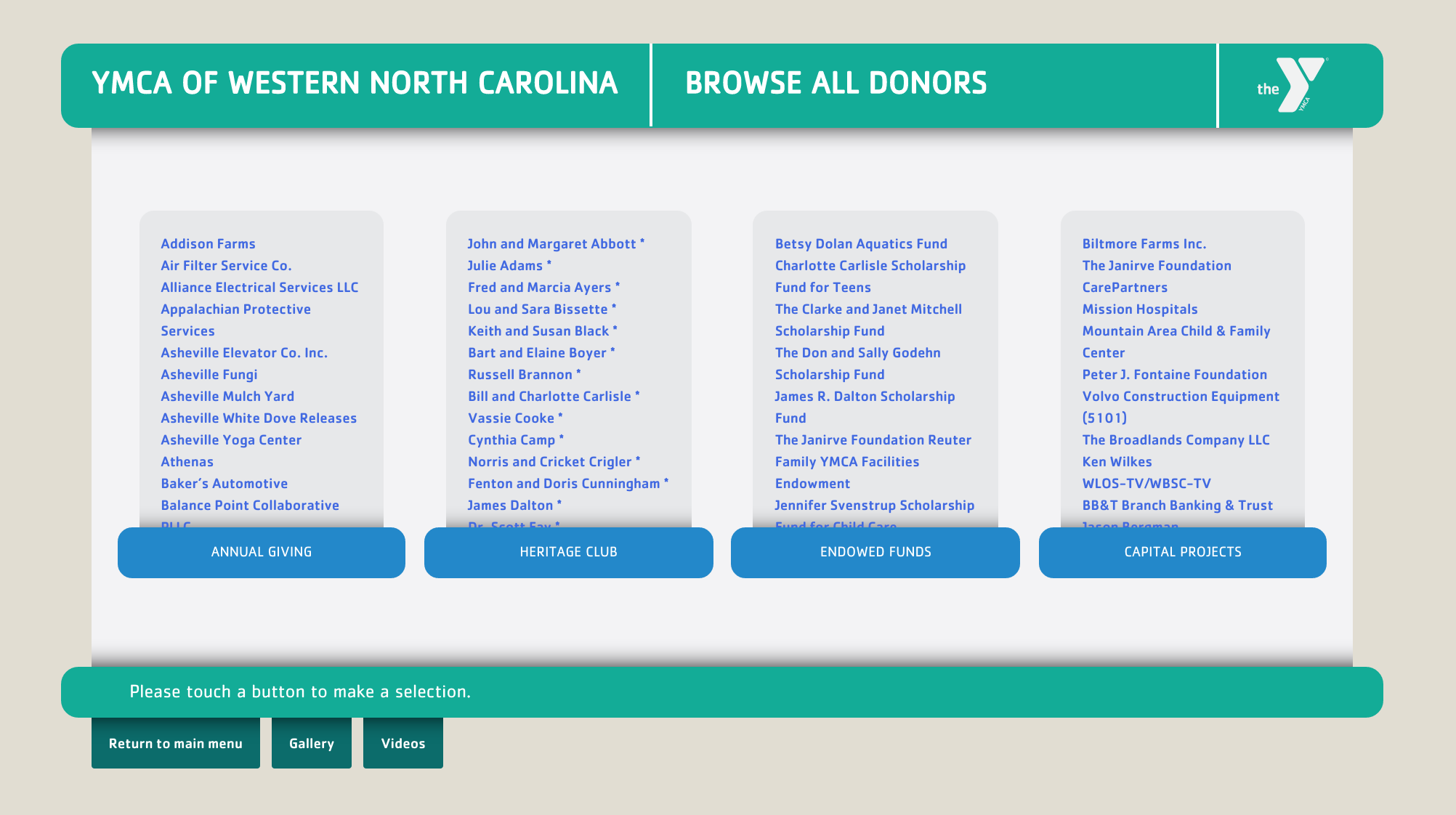Challenges and Advantages for Digital Donor Recognition
Branded Digital Donor Recognition Displays - YMCA of Western North Carolina, multiple branches
There are benefits and compromises inherent in the decision to use a screen to present donor recognition. A traditional donor wall allows a passive viewer to understand a considerable amount of information about the relationship between an organization and its donors without reading a single name. One can glean an idea of the number of donors from the size of the list. If a hierarchy of plaque sizes or categories is part of the display, those details let the viewer know that people give different amounts. The location of the display, the environment surrounding it, and the materials used to build it all help indicate the value the organization places on its donor. The best donor walls motivate the viewer to consider giving and explain how to make a gift.
With digital donor recognition, a catch all term for any type of recognition presented on a screen, many of the context clues are lost. It is harder to understand how many donors are represented in the display, if the donors are categorized in some way, and how philanthropy is situated within the priorities and values of the organization. Exploration and a general understanding of the topic require far more action on the part of the audience.
Systems for organizing digital donor recognition information that is distinct and easy to navigate is still evolving. Most models follow the stacking logic used by simple websites or include a game-like trick to keep users engaged. Importantly, the information letting the viewer know how to give is often presented as a separate page leading to a distinctly different visual experience, thereby over-emphasizing the “ask” in relation to the content that is intended as a thank you for those who have already given.
Digital donor recognition should identify the scope of information contained in the presentation, how that information is arranged, and multiple ways to explore it. While systems that include a search by donor name easily support finding information about a specific donor, only a few users seek information in that way. Many more users depend on motivating content and a well-defined structure to find and then explore the information not immediately presented by the display.
Digital donor recognition should provide a version of the value and appreciation messages typical of a facility-based experience and encourage the user to spend more time exploring the available content.
There are advantages to digital donor recognition that should not be overlooked. Most organizations are attracted to the speed and cost-effectiveness of updating the content of a digital display. The opportunity to store and display a far larger volume of information is an advantage often overlooked. Traditional hardscape donor walls typically have an “entry level,” a minimum amount of money given to be listed on the wall. This strategy is based on the limitations of the size of the wall and the cost of adding names. With digital systems, the cost to add and maintain a name is minimal allowing far more inclusivity in the number and variety of donors listed.
The versatility of the media is also providing greater opportunity for philanthropic storytelling. It is now possible to create, store and redistribute stories to and about donors. These stories make the overall recognition experience far more specific and complete for the donor and give all audiences a wider array of information about those who support the organization, the variety of ways to support, and the impact made possible through philanthropic giving.
It is important to draw a distinction between the passive and active interaction inherent in the digital donor recognition experience. Most people will “view” the experience the display passively, seeing only the content that is presented to them. In designing these components, the images on the screen should be thought of as billboards–quick, easy to digest bits of information that can be understood by any person passing by. The more comprehensive content is often hidden behind these billboards and requires active engagement by the audience. They must become “users” of the experience. These distinctions are important in the design of the content map and user interface for any digital donor recognition experience. Developing engaging passive experiences is key to enticing the audience to move from viewer to user.
Cross-purposing digital content from large facility-based screens to web applications meant for use on desktop or mobile devices is now taking donor stories to an even broader audience. Organizations are now able to broadcast their donor recognition and philanthropic communication to a wider audience and to share it via social media. It is no longer necessary to visit a facility or campus to understand the relationship between an organization and its donors or to receive the messages of gratitude for which donor recognition was originally designed. With careful crafting, the digital donor recognition experience can provide greater access, ease of use, cost-efficiency, and an experience of the appreciation felt for those who provide philanthropic support for the organization.
Presenting supporters names and stories to the public is a well-established practice for showing appreciation and motivating new giving. New technologies are expanding the ways in which donor recognition can be achieved. These new methods offer benefits such as cost-savings and repurposing content, however, care must be taken to effectively translate the viewer’s experience from traditional hardscape donor walls to the digital experience. Without an awareness of the way in which information is received and the ability to present concepts larger than the individual donor’s name, the core functions of donor recognition may be weakened in the digital environment.
Written By Anne Manner-McLarty
Anne Manner-McLarty is the managing editor of the Journal of Donor Relations and Stewardship. She founded Heurista in 2011, a leading resource for consulting specific to donor relations and stewardship, with particular expertise in the donor recognition program design and implementation.





